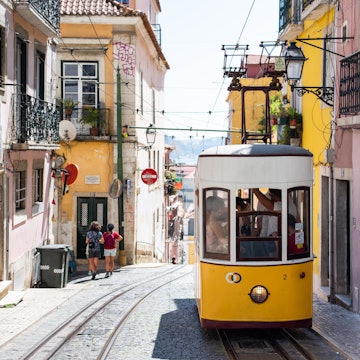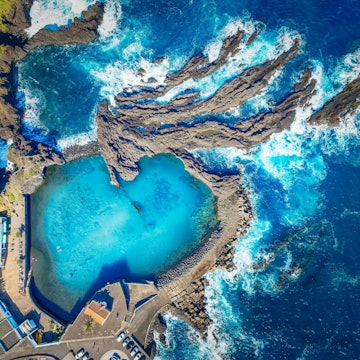
How to get the most out of the Azores without renting a car

Jul 12, 2023 • 10 min read

It’s hard but not impossible to explore this Atlantic archipelago without renting a car - here’s your detailed guide © Daniel James Clarke
In this series, we take you step by step through how we planned some of the most complicated travel adventures, so you can recreate them yourself with ease. Here, Daniel James Clarke explains how it’s possible to tackle the Azores without renting a car.
In the Azores, slowing down isn’t a trend; it’s a centuries-old way of life. Ferries operate at the whim of the waves, whale sightings reward those with patience and sweet-scented, hydrangea-lined trails are destinations unto themselves. Even the southernmost of these nine volcanic specks has continued to rise gradually for millions of years. Life in the middle of the Atlantic is blissfully unhurried, and while exploring these islands without a car might take some extra planning, the dividends of leaning into the local pace are manifold.
I plotted my first trip to Portugal’s largest autonomous archipelago during the initial pandemic lockdown. With an abundance of time, I buried myself in bus timetables, ferry schedules, flight routes and trail maps, devising a detailed Azores itinerary that wouldn’t require a rental. Much of the advice online made this seem a near-impossible mission, yet after studying seasonal schedules and shuffling dates – pencil and eraser in hand – an unforgettable vacation came together. A second one followed not long ago.

Since then, the motivations to visit the Azores car-free have multiplied. Rental costs have soared, supply continues to outstrip demand in peak season, car transport on ferries is limited and a renewed concern for sustainability has accompanied the increasing number of arrivals. Sadly, the Linha Amarela ferry line, which linked eight of the nine Azores together in the summer and made flight-free inter-island trips easy, was indefinitely suspended in 2022. Still, for those seeking more eco-conscious adventures, a cluster of islands remain explorable year-round without the need for internal flights.
Whether you’re keen to explore the islands by bus, bike, boat or hiking boots, these are the five steps to planning your own seamless and sustainable Azores itinerary without a car.

Step 1: Pick your islands and adventures
Before even considering browsing flights, you’ll face two essential questions: which island(s) do you want to visit, and how do you want to get around? I get that it’s tempting to tour as many as possible – but trust me, you would need at least one (fast-paced) month to do so enjoyably, and that’s before factoring in Mother Nature derailing plans through rough waves and canceled ferries. So getting specific on what type of adventure you’re after will shape the rest of your planning.
Looking for an effortless yet enchanting first-timer’s island ideal for a quick visit? Plump for Ponta Delgada as a city base to take day trips across São Miguel. Eager to go island hopping and witness diverse landscapes? Traverse the central trio of Pico, Faial and São Jorge. Want to get away from it all on a multi-day hike with just a map, tent and backpack? The waterfall-heavy island of Flores is calling.
Each island has plenty of parallels: volcanic landscapes, lush vegetation and cetacean-laden cerulean waters – but also distinct personalities. Our guide to the nine islands is a helpful introduction; from a getting-around point of view, here’s more you should know about the three island groups to decide if you’d prefer a single base or a multi-stop journey.

The eastern group
The two inhabited islands of the eastern group, São Miguel and Santa Maria, are hardly twins. The Azores’ capital and its largest island, São Miguel is a hotbed of gurgling geysers, swell-friendly shores and lush lake trails, while Santa Maria is more about sun, sea, sand and strolls. What they do have in common, though, are decent networks of bus routes and hiking trails, making day trips easy – though there is currently no ferry between the two, or indeed any public ferries.
The central group
Five islands form the Azores’ central group; from a travel perspective, they are best treated as two subgroups. In the north, laid-back and lesser-visited Graciosa and internationally connected Terceira have reasonably decent bus schedules – especially if you use Unesco-listed Angra do Heroismo or Lajes as a base. From June until September, the two islands are linked by a summer-only ferry route, which also connects with the other three islands of the central group.
To the south, Pico, São Jorge and Faial – known as the “Triangle Islands” – are huddled relatively close together and bound by year-round ferry sailings, making them the best flight-free island- hopping choice. Within one week, you could climb Mt Pico (Portugal’s highest peak), admire Unesco-listed volcanic vineyards, marvel at the alien-like landscape of Capelinhos (formed from a 1957 eruption), and sample both São Jorge’s famous cheese and its fajãs (ocean-meeting flat lava spills). Buses operate on all three islands, though an occasional taxi or longer trek might be needed. Slender-yet-soaring São Jorge has topography that can be particularly demanding, with fewer public transport connections.
The western group
While far-flung Flores and tiny Corvo may involve a slightly longer journey, the mesmerizing landscapes are worth it. What’s more, their proximity and year-round ferry service make it easy to see both in one visit. You can expect heart-stirring waterfalls, some of Portugal’s most scenic hikes and multiple photogenic miradouros (viewpoints). Compact Corvo is easily explored on foot, while Flores’ trails (combined with the limited bus network) make this a hiker’s utopia.
Getting between the three island groups is only possible by internal flight, something those looking to reduce their carbon footprint should consider.

Step 2: Decide when to visit
In addition to thinking about crowds, higher prices and seasonal ferry timetables, there are a few other factors to consider when deciding which season to visit.
Bus schedules are mainly designed around commuters and school schedules, meaning services can be reduced during holiday periods and sometimes non-existent on weekends – which means mid-week trips are advised. The winter can bring fierce waves to the Atlantic and storms to the skies, leading to potentially delayed or canceled flights and ferries. Additionally, some tours, transport offerings, direct flight routes and hiking trails are suspended in the winter.
None of this makes it impossible to explore multiple islands in winter – indeed, some would say that serene season is a delight – but you’ll need to pay attention to the elements, and many would urge a car to escape any potential downpours.
I’d suggest spring or autumn as the best time to visit the Azores car-free, as schools have resumed, the whale-watching season is in swing (it runs April until October) and trails are usually well maintained. For full-bloom hydrangeas, plan your visit between May and early summer.
Step 3: Plan your arrival and departure points, and trip length, based on flight options
Reaching the Azores has become more straightforward in recent years, with direct flights from Toronto, Boston, New York, London and many Continental European cities. Keep in mind some of these routes are only seasonal, and only São Miguel (and to a lesser extent Terceira) receive international flights. From either of these, you can continue on to other islands.
Sadly, there is no Lisbon–Azores ferry service, making it impossible to reach the islands “flight-free.” The most sustainable option for Europeans would be to travel overland to Portugal, then take a shorter flight from Porto or Lisbon. From the capital, you can fly directly to additional islands, including Santa Maria, Pico, Faial, São Miguel and Terceira, meaning arriving and departing from different islands is possible, helping to avoid internal flights when ferries offer an alternative.
On the ANA Aeroportos website, you can check the public transport options from each airport. Taxis also meet every flight.

Step 4: Study schedules, trails and maps to make a detailed itinerary
With the when, where and how established, it’s time to do some final timetable and trail checks to stitch it all together. For this, you’ll need to take a deep breath before taking a deep dive into the seasonal schedules and trail maps. Soon enough, your planning paper will be complete.
My best advice at this stage is to remember that ferry and flight delays do happen both for operational and weather reasons, so you should always allow a bit of a buffer. Don’t try to do one island per day (except maybe Corvo), and always arrive back to your final island at least one day before your onward flight.
Atlânticoline ferries
The Azores have one only ferry operator, Atlânticoline, which currently operates four seasonal and two year-round routes (although the frequency reduces in winter). Some islands, such as Pico and São Jorge, have two ports, which can be used to your advantage to avoid looping back. Most harbors are within walking distance to the nearest town; others are connected by bus.
Sometimes only the schedules for the current year render on Atlânticoline’s website, with the new winter routes starting January usually posted after summer. The line’s Facebook page is worth checking during your trip to track any unscheduled changes.
Buses
Most bus timetables are for the benefit of school kids and commuters, meaning morning and afternoon loops are the standard and weekend services are limited (if they exist at all). When consulting the timetables, confirm if you’re traveling in a school period, and be aware that dias úteis means working days (Monday to Friday).
To make things more complicated, each of the Azores islands has a different bus operator. Most of the schedules can be consulted online (although São Jorge’s limited service does not have a website, and Corvo has no public transport at all). Enjoy digging into the timetables for Santa Maria, Terceira, Graciosa, Pico, Faial and Flores; São Miguel has three operators, Cristiano Limitada, Auto Viação Micaelense and Varela.

Hiking trails
Getting around the Azores on your own two feet isn’t just a great way to explore the islands on a budget: hiking is arguably the archipelago’s main draw. A maze of well-marked and spectacular circular and linear trails are found on all the islands, with a choice between two types of hikes: GR (multi-stage grand routes) and PR (small routes). Maps for each – download the trail leaflet for the clearest overview – are accessible online.
It’s common for hikers and cars to share the road (excluding highways and vehicle-reserved routes), and this can be handy if you’re planning to use a multi-day hike to explore more of the Azores without staying in just one base – especially if you’re using campsites.
Bike routes
Depending on which island you’re crossing, cycling the Azores can be a sweaty, steep adrenaline rush or a pleasantly flat lark. Azores Tourism details the official road, cross-country and endurance routes on its website, and bike-rental companies can be found on most islands. You’ll want to reserve ahead if cycling becomes an integral part of your itinerary.
Taxis and tours
Taxis can be helpful to reach the start of a linear trail that isn’t reachable by bus, as can day tours to more-remote sites. Given the cost of a rental car in the summer months, this can still be the cheaper option.
Taxis operate by meters on the islands, though transfers or half-day options can be pre-arranged at a fixed fee. Azores Tourism has a list of local taxi numbers; it’s best to pre-book, although taxi stands are found in major towns. There are no ride-sharing apps operating in the Azores.

Step 5: Book your flights, ferries and hotel reservations as far ahead as possible
With your planning paper now revised, updated and finalized – eraser marks and all – it’s time for the payoff: booking your dream car-free trip to these Eden-like isles.
Make your flight reservations, secure your hotels and book any ferry crossings (if reservations haven’t opened yet, check back every few weeks) as far in advance as possible. The Azores are having their moment, and it’s not only car-rental demand that surges in summer.
It’s also advisable to have insurance in case any unwelcome weather upends your plans, and to check visa requirements for Portugal.
If I could do it all again…
My biggest takeaway from my two car-free trips to the Azores is to plan a spare day, especially if you’re traveling in the shoulder seasons, when weather can derail your plans. On hikes, always pack enough water and a picnic – Azores sweet pineapple, bolo lêvedo (a slightly sweet muffin-like bread) and queijo São Jorge work perfectly – as restaurants might be closed. Perhaps most importantly, make the time to swim whenever you can: the salty kiss of the Azores’ Atlantic waters is something special indeed.















